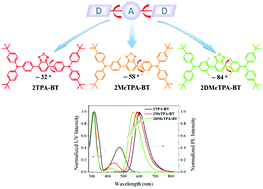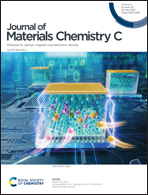High-efficiency organic electroluminescent materials based on the D–A–D type with sterically hindered methyl groups†
Abstract
Three donor–acceptor–donor type emitters of 2TPA-BT, 2MeTPA-BT and 2DMeTPA-BT were synthesized. Crystal structures for all compounds were determined by single-crystal X-ray diffraction analysis, showing that by introducing one or two methyl groups between the donors and acceptor, the spatial configuration changes greatly for 2MeTPA-BT and 2DMeTPA-BT compared to their parent compound 2TPA-BT. Density functional theory analysis reveals that the emission of 2MeTPA-BT has a more obvious hybridized local and charge-transfer (HLCT) feature based on the influence of steric hindrance of methyl substituents. Attributed to their different spatial configurations and luminescence mechanisms, different emission wavelengths with high photoluminescence quantum yields (ΦPLs) of 75.43%, 93.43% and 89.63% in toluene solvent, as well as 44.76%, 52.19 and 33.87% in neat film, were observed for 2TPA-BT, 2MeTPA-BT and 2DMeTPA-BT, respectively. Furthermore, strong electroluminescence was observed with the emission peaks at 602, 560 and 544 nm, maximum current efficiencies of 11.05 cd A−1, 30.40 cd A−1 and 25.02 cd A−1, maximum power efficiencies of 6.01 lm W−1, 23.67 lm W−1 and 20.37 lm W−1, and maximum external quantum efficiencies of 4.43%, 8.47% and 7.29% for 2TPA-BT, 2MeTPA-BT and 2DMeTPA-BT doped organic light-emitting devices (OLEDs), respectively. This work clearly illustrates the effect of spatial configuration changes on the luminescence properties of organic emitters.



 Please wait while we load your content...
Please wait while we load your content...